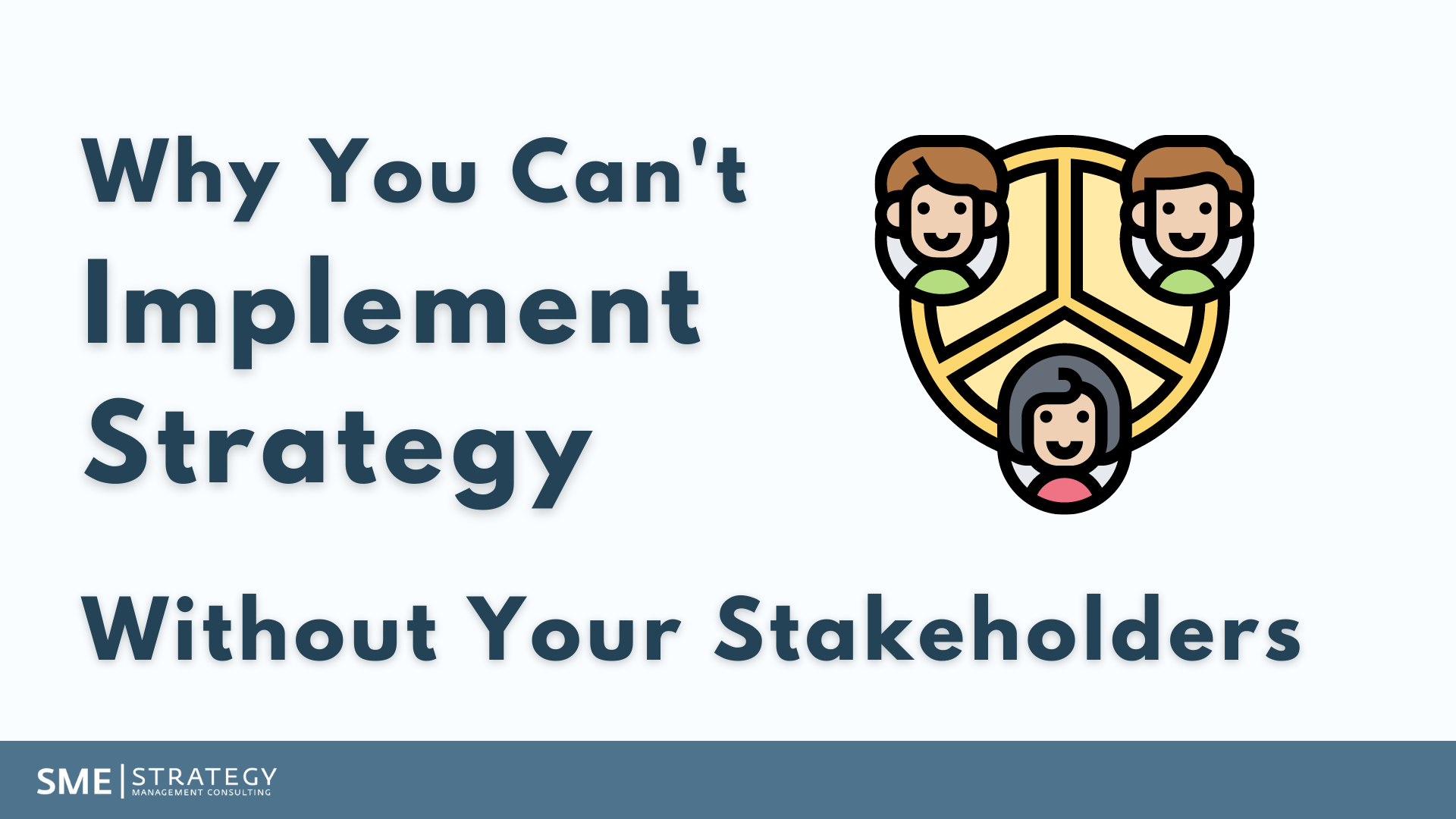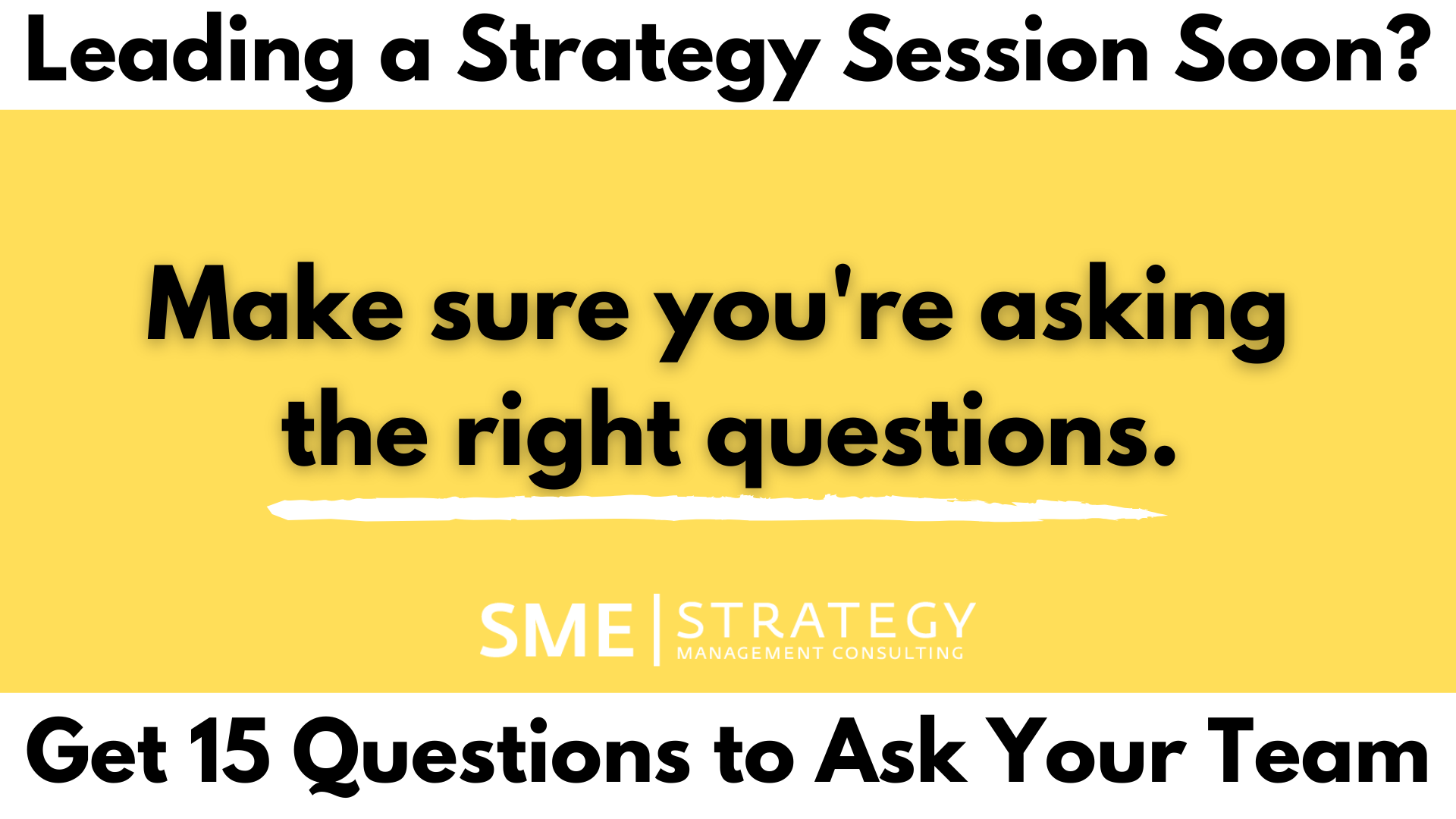
SME Strategy is a strategy consulting company that specializes in aligning teams around their vision, mission, values, goals and action plans. Learn more about how we can help align your team with our strategic planning and implementation services.
I'm gonna let you in on a little secret. You cannot successfully implement your strategic plan without engaging your stakeholders. In this video, I'm going to show you the number one tool you can use to figure out who your stakeholders are, and how to prioritize engaging with them, so you can implement your strategy successfully.
So my name is Anthony Taylor, I'm the Managing Partner at SME Strategy. For the past 10 years, I've been leading groups through strategic planning exercises, engaging with groups large and small to help them figure out what they need to do and how to get to where they want to go.
One of the tools that we use as part of that is stakeholder engagement. Today, I want to highlight why you can't implement your strategy successfully without engaging your stakeholders. I've seen good examples and I've seen bad examples of this. But it's one of those hidden things, that if you don't think about your stakeholders as part of your strategy implementation, you're going to have a bad time. So that's either internal stakeholders or external stakeholders. But I'll tell you a little bit more about what those are right now.
What is a stakeholder & why should you care?
So what is a stakeholder? A stakeholder is anybody that has an interest or concern with your organization, or about your organization or company. So they could be internal or external, they could be employees, but they can also be the public partners, governing bodies, policymakers, owners, etc. So consider that you have very many groups that are stakeholders in your business and your organization.
We can help you align your team around a clear vision, mission, values, goals and action plans,
so you can lead your organization more effectively and get better results.
Why do you need to care? Because all of these people care about you. Now, they either care about you because they have a vested interest in it, or they are just interested. In some cases, the stakeholders might have decision making power. So you know, if you're trying to build a building, you have to make sure that the government is on your side to give you the permit. If you are a CEO, you need to make sure that your board is on your side. If you're trying to create a plan, and you're the marketing team lead, you got to make sure that your marketing team is bought into what you're doing. Otherwise, you're gonna have a bad time. So the key part of why you should care is aligning and making sure that everybody's expectations are the same. If you don't have aligned expectations with your stakeholders, and different people have different interests, you're going to have a bad time.
So how to successfully manage your stakeholders? The key thing is engaged them early. You have to think of getting people on your side and aligning those expectations - aligning the outcomes, and making sure that everybody is bought in to what you're doing. I found human nature to be - if you're not bought into something, you're probably negative. I'd say that generally, people swing to negative and not neutral. So if you think of doing stakeholder engagement early, it's going to lower the chance of surprise, it's going to lower the chance of arguments or frustration or conflict, and it's going to support you in developing ownership and accountability to your plan. So making sure that you engage people on the front end, so that they're pro what you're doing. Instead of moving forward and not getting their buy-in, and having to deal with challenges.
If you don't engage your stakeholders..
So what happens if you don't engage them? Your plan is going to stall. You're going to have to spend so much more time, money and energy being reactive, and dealing with frustrations, then had you dealt with it on the front end. What happens if you don't engage people? They're gonna feel like the organization is moving forward without them. Even though that might not be the case. It's their perception that you have made a decision independently of them. Depending on where they sit on the stakeholder map, which I'll show you later, they might feel slighted by it, even though in your mind, you are totally going to have them on board in the first place. They're not going to feel accountable or responsible. So they're not going to really have that partnership.
For certain endeavors, if you're in a team, if you're leading a board, if you're working with customers, they need to be part of that. You need that buy in if you don't get the buy-in, you're going to have a bad time. And like I mentioned earlier, they might actively fight against your plan, actively fight against your objectives. I've seen it so many times where somebody made a plan - they went on with it without consulting key stakeholders, and that person made such a big stink, even though they were fundamentally aligned. They were slighted that they never got communicated with and engaged with on the front end. So if you don't engage people in your plan, like to a little degree, they might really ruin your plans and give you a hard time as you move forward.
Getting buy-in from stakeholders
So what's the first step in making sure that you have the buy-in and engagement from your stakeholders? Start by mapping them. So as part of the strategic planning process, in some cases, when we do stakeholder engagement, we map them in terms of influence and interest. So you might not have enough time, money, or energy to address all of your key stakeholders. So what you want to do is figure out who has the highest influence and who has the highest interest, and then balance those people through a stakeholder engagement plan or stakeholder engagement strategy. It'll help you mitigate the biggest opposition or the biggest challenge challengers, or get those people on your team to help move the plan forward.
If they have high influence and high interest, engage with them regularly, make sure that they're happy, and figure out how you need to prioritize your stakeholder energy in the right domains. So number one steps start by mapping them, and then you can work at engaging with them after the fact.
Key takeaways
So what I want you to take away from this video - you have more stakeholders than you realize. So if you never go through the process of mapping them, you might not know how many different groups of stakeholders you have, which means that it's going to be impossible for you to engage with them effectively. I highly recommend you front load the process, because doing it proactively is less costly, both in time, money, and energy than doing it after the fact reactively. Stakeholders - if not engaged, most certainly, or almost certainly will slow down your progress. So don't engage with them at your own peril.
Finally, as you look at balancing your resource allocation, and your time allocation, balance the high power high interest. Do your best to manage and engage with as many stakeholders as possible, so you get the maximum buy-in, maximum alignment and maximum impact.
Need help with your strategic planning process? A facilitator can help:
So I hope that helps you better understand the importance of stakeholders as part of the strategy implementation process. If you'd like some more information about how we do stakeholder engagement, we lead conversations with stakeholders to really understand where they're at, what their needs are, and use those inputs for the strategic plan process and strategy implementation process.
For example, you might be a senior management team or senior leadership team, you've created your strategic plan. Now you need to roll it down to your line managers or middle managers. That's an example of stakeholder engagement that you could push a message on them, or you could pull them into it through an engaging conversation, to make sure that you have their buy-in.
The amount of time it takes on the front end is so much shorter than it is struggling for 6, 9, or 12 months on the back end trying to get them bought in. So if you'd like some more information, click the link on this video to learn more about working with our team. We can help you through that process and help move your team move forward in an aligned way.
My name is Anthony Taylor. I hope you enjoyed this video on stakeholder engagement. If you have any other tricks or tips, be sure to drop them in the comments. Be happy to hear what you do well to engage your stakeholders and get them bought in.
I appreciate you watching, and I'll see you in the next video!




